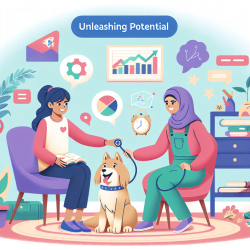As a passionate advocate for creating positive outcomes for children, I am always on the lookout for innovative, data-driven approaches to therapy. One such promising approach is the use of Dog-Assisted Interventions (DAI), as detailed in the recent research article "Development of Desirable Behaviors in Dog-Assisted Interventions" by Acebes et al. This integrative method for training dogs to be part of therapeutic interventions has the potential to revolutionize child therapy, particularly in online settings such as those provided by TinyEYE.
Dog-Assisted Interventions involve specially trained dogs in therapeutic settings to improve human health. The training methods for these dogs are often based on traditional techniques passed down through trainers, which may not incorporate the latest scientific research on dog cognition and learning. The research by Acebes et al. aims to bridge this gap by presenting an integrative method that aligns with the cognitive and emotional needs of the dogs, ensuring their well-being while promoting desirable behaviors for therapeutic interventions.
The Key Takeaways for Practitioners
Here are some actionable insights from the research that practitioners can implement to enhance their skills and improve therapy outcomes:
- Focus on Natural Behaviors: The research emphasizes the importance of developing natural behaviors in dogs that are beneficial for interventions, such as trust, absence of fear, and trainability. By focusing on these behaviors, practitioners can ensure that the dogs are well-suited for therapeutic settings.
- Use Social Reinforcements: Instead of relying on food rewards or aversive stimuli, the research advocates for using social reinforcements like affection and social facilitation. This approach not only strengthens the bond between the dog and the human but also enhances the overall therapeutic experience.
- Promote Cognitive Development: The integrative method encourages the cognitive development of dogs through interactive and decision-making processes. This not only makes the training more effective but also ensures that the dogs are active participants in the learning process.
- Minimize Unwanted Behaviors: By controlling the training context and promoting incompatible behaviors, practitioners can effectively minimize unwanted behaviors in dogs. This approach is less intrusive and more humane, aligning with best practices in animal welfare.
Encouraging Further Research
While the integrative method presented by Acebes et al. is a significant step forward, it is essential for practitioners to continue exploring and contributing to the body of research on Dog-Assisted Interventions. Here are some ways to get involved:
- Collaborate with Researchers: Share your observations and experiences with researchers in the field of dog cognition and learning. This collaborative approach can lead to more effective training methods and better therapy outcomes.
- Conduct Pilot Studies: Implement the integrative method in your practice and conduct pilot studies to assess its effectiveness. Share your findings with the broader community to contribute to the growing body of evidence supporting DAI.
- Stay Updated: Keep abreast of the latest research and developments in the field. This will ensure that your practice is always aligned with the best and most current scientific knowledge.
In conclusion, the integrative method for training dogs presented by Acebes et al. offers a promising approach to enhancing Dog-Assisted Interventions in child therapy. By focusing on natural behaviors, using social reinforcements, promoting cognitive development, and minimizing unwanted behaviors, practitioners can create more effective and humane therapy experiences for children.
To read the original research paper, please follow this link: Development of Desirable Behaviors in Dog-Assisted Interventions.










